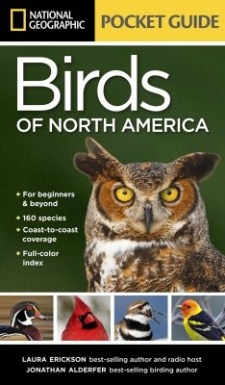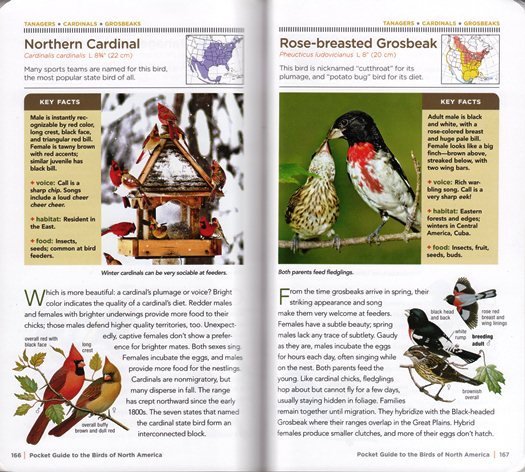Reviewed by Grant McCreary on October 6th, 2013.
I had a good many bird books as a child, including some “pocket” guides. I enjoyed looking through these books, mostly for the pretty pictures of birds that were still exotic to me. I still have those books today. But it’s clear that pretty pictures are the only thing they were good for. Nearly three decades later, there are still pocket guides being published. But at least one, National Geographic Pocket Guide to the Birds of North America, is more than just pretty pictures.
National Geographic’s pocket guide includes 160 of the “most common and iconic” North American birds. The title is not an exaggeration – if you have a pocket, this book should fit in it. Yet it is still big enough to ensure that each species gets an entire page that includes a photograph, illustrations from the National Geographic field guide, range map, and text.
My biggest complaint with small-format guides is that they don’t generally include enough illustrations to identify anything beyond breeding-plumaged males. But Erickson and Alderfer took a very good approach here. In addition to the single (relatively) large, eye-catching photograph, they include illustrations from National Geographic’s flagship field guide. They even include helpful annotations. The most important variations are illustrated here, which will allow the user to identify more birds (such as a female cardinal, which some of my older pocket guides didn’t even show). Moreover, it frees up the photo to display interesting behavior or some other cool aspect of the bird. The picture selection is, on the whole, fantastic and makes the guide much more enjoyable and lively. Anyone looking at the shot of the Eastern Phoebe fledgling on page 106 won’t be able to keep from smiling…and then having their jaw drop upon seeing the facing page where three Eastern Kingbirds take on a Bald Eagle (with one striking its head!).
The text is surprisingly extensive for a pocket guide. Some “key facts” flank the photo and give notes on identification, voice, habitat, and food. The main section of text presents interesting facts about the bird, usually relating to habits and other things not directly relevant to identification.
You can’t produce a book like this without some seriously hard choices on which species to include. Any experienced birder will have some quibbles over birds that were or were not selected. For example, I’m surprised that Pileated and Red-headed Woodpeckers are not included, while the range-restricted Roseate Spoonbill and Wood Stork are. But on the whole, the selection seems satisfactory. It helps that the authors have done two things to effectively include more birds. First, although there’s an account for only one bird of closely related pairs, it will mention the other. Of the chickadees, for example, only the Black-capped is included. However, a careful reading of the account will reveal that “the very similar Carolina Chickadee is found in the South.” Second, there are five two-page spreads that show additional species of these groups: ducks, raptors, pelagic species, warblers, and sparrows. Each of these spreads shows, on average, 17 additional birds.
A short introduction offers an “invitation to birding”, giving some basic information on identifying and finding birds, optics, and how to use the guide. It covers the highpoints well, but, given that this guide may be someone’s introduction to birds and birding, perhaps it should have been a bit longer.
Recommendation
National Geographic Pocket Guide to the Birds of North America is a great introduction to North America’s common birds, promoting not only identification but also a genuine interest in birds. It is ideal for those who are interested in birds, but not yet a birder. But earnest birders, even beginners, would be better served by a full field guide.
Disclosure: I get a small commission for purchases made through links in this post.
Buy from NHBS
(based in the U.K.)
Disclosure: The item reviewed here was a complementary review copy provided by the publisher. But the opinion expressed here is my own, it has not been influenced in any way.







Comment